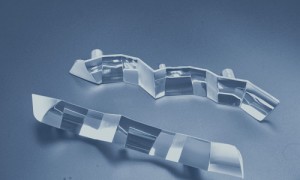What is CNC aluminum?
Views: 206 Update date: Sep 04,2024
CNC aluminum refers to aluminum parts or components that are manufactured using Computer Numerical Control (CNC) machining processes. This advanced manufacturing technique allows for the precise and automated production of complex aluminum parts based on digital designs. Let me elaborate on various aspects of CNC aluminum:
- Lightweight yet strong
- Corrosion-resistant
- Good thermal and electrical conductivity
- Easily machinable
- Recyclable
- Computer-aided design (CAD) of the part
- Conversion of the design into a set of instructions (G-code) for the CNC machine
- Setting up the aluminum workpiece in the CNC machine
- Automated cutting, drilling, milling, or turning of the aluminum according to the programmed instructions
- Finishing processes such as deburring, polishing, or anodizing
- CNC Lathes: For creating cylindrical parts
- CNC Routers: For cutting sheets of aluminum
- Consistency in production
- Ability to create complex geometries
- Scalability from prototypes to mass production
- Reduced waste compared to traditional machining methods
- Time-efficient for large production runs
- Aerospace: Aircraft components, satellite parts
- Automotive: Engine components, chassis parts
- Electronics: Heat sinks, enclosures
- Medical: Surgical instruments, implant components
- Consumer goods: High-end product casings, sports equipment
- 6061: General-purpose alloy with good strength and corrosion resistance
- 7075: High-strength alloy often used in aerospace applications
- 5052: Good for marine environments due to excellent corrosion resistance
- 2024: High strength-to-weight ratio, often used in aircraft structures
- Anodizing: Creates a durable, corrosion-resistant surface layer
- Powder coating: Applies a decorative and protective finish
- Polishing: Achieves a smooth, reflective surface
- Brushing: Creates a textured, non-reflective finish
- Minimum wall thickness to prevent warping or breakage
- Internal corner radii to accommodate cutting tool sizes
- Avoiding deep cavities that may be difficult to machine
- Designing for efficient fixturing during machining
- Dimensional inspection using coordinate measuring machines (CMMs)
- Material composition verification
- Non-destructive testing methods like X-ray or ultrasonic inspection for critical components
- Complexity of the design
- Quantity of parts ordered
- Type of aluminum alloy used
- Tolerance requirements
- Surface finish specifications
- Post-machining treatments or finishes required
In conclusion, CNC aluminum represents a versatile and efficient method of producing high-quality aluminum parts with complex geometries and tight tolerances. Its widespread use across multiple industries underscores its importance in modern manufacturing processes.
Prev: What is the easiest aluminum to CNC?
Next: How much does CNC machinery cost?
1. Material:
Aluminum is a popular choice for CNC machining due to its excellent properties:- Lightweight yet strong
- Corrosion-resistant
- Good thermal and electrical conductivity
- Easily machinable
- Recyclable
2. CNC Machining Process:
The CNC machining process for aluminum involves:- Computer-aided design (CAD) of the part
- Conversion of the design into a set of instructions (G-code) for the CNC machine
- Setting up the aluminum workpiece in the CNC machine
- Automated cutting, drilling, milling, or turning of the aluminum according to the programmed instructions
- Finishing processes such as deburring, polishing, or anodizing
3. Types of CNC Machines Used:
- CNC Mills: For creating complex 3D shapes and features- CNC Lathes: For creating cylindrical parts
- CNC Routers: For cutting sheets of aluminum
- Multi-axis CNC Machines: For creating intricate parts with complex geometries

4. Advantages of CNC Aluminum:
- High precision and accuracy- Consistency in production
- Ability to create complex geometries
- Scalability from prototypes to mass production
- Reduced waste compared to traditional machining methods
- Time-efficient for large production runs
5. Common Applications:
CNC aluminum parts are widely used in various industries, including:- Aerospace: Aircraft components, satellite parts
- Automotive: Engine components, chassis parts
- Electronics: Heat sinks, enclosures
- Medical: Surgical instruments, implant components
- Consumer goods: High-end product casings, sports equipment
6. Aluminum Alloys for CNC Machining:
Different aluminum alloys are chosen based on the specific requirements of the part:- 6061: General-purpose alloy with good strength and corrosion resistance
- 7075: High-strength alloy often used in aerospace applications
- 5052: Good for marine environments due to excellent corrosion resistance
- 2024: High strength-to-weight ratio, often used in aircraft structures
7. Finishing Options:
After CNC machining, aluminum parts can undergo various finishing processes:- Anodizing: Creates a durable, corrosion-resistant surface layer
- Powder coating: Applies a decorative and protective finish
- Polishing: Achieves a smooth, reflective surface
- Brushing: Creates a textured, non-reflective finish
8. Design Considerations:
When designing parts for CNC aluminum machining, it's important to consider:- Minimum wall thickness to prevent warping or breakage
- Internal corner radii to accommodate cutting tool sizes
- Avoiding deep cavities that may be difficult to machine
- Designing for efficient fixturing during machining
9. Quality Control:
CNC aluminum parts often undergo rigorous quality control measures:- Dimensional inspection using coordinate measuring machines (CMMs)
- Material composition verification
- Non-destructive testing methods like X-ray or ultrasonic inspection for critical components
10. Cost Factors:
The cost of CNC aluminum parts depends on various factors:- Complexity of the design
- Quantity of parts ordered
- Type of aluminum alloy used
- Tolerance requirements
- Surface finish specifications
- Post-machining treatments or finishes required
In conclusion, CNC aluminum represents a versatile and efficient method of producing high-quality aluminum parts with complex geometries and tight tolerances. Its widespread use across multiple industries underscores its importance in modern manufacturing processes.

